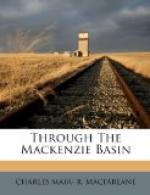The foliage here and there showed signs of change, some poplars yellowing already along the immediate banks, and the familiar scent of autumn was in the air. In a word, the change so familiar in Manitoba in August had taken place here, to be followed by a balmy September and the fine fall weather of the North, said to surpass that of the East in mildness by day, though perhaps sharper by night. We were now but a few miles from the last obstruction, the Pelican Rapids, and pushed on in the morning along banks of a coal-like blackness, loose and friable, with thin cracks and fissures running in all directions, the forest behind being the usual mixture of spruce and poplar. By midday we were at the rapids, by no means formidable, but with a ticklish place or two, and got to Pelican Portage in the evening, where were several shanties and a Hudson’s Bay freighting station. Here, too, is a well which was sunk for petroleum, but which struck gas instead, blowing up the borer. It was then spouting with a great noise like the blowing-off of steam, and, situated at such a distance from the shaft at the Landing and from the Point Brule spiracle described, indicated, throughout the district, available resources of light, heat and power so vast as almost to beggar imagining.
Mr. Ross having obtained on the 14th the adhesion of the Crees to the Treaty at Wahpooskow, it was now decided that the Scrip Commission should make the canoe trip to that lake, whilst Mr. Laird and party would go on to Athabasca Landing on their way home. Accordingly Matcheese—“The Teaser”—a noted Indian runner, was dispatched with our letters to the Landing, 120 miles up the river. This Indian, it was said, had once run from the Landing to Edmonton, ninety-five miles, in a single day, and had been known to carry 500 pounds over a portage in one load. I myself saw him shoulder 350 pounds of our outfit and start off with it over a rough path. He was slightly built, and could not have weighed much over nine stone, but was what he looked to be, a bundle of iron muscles and nerves.
On the 29th Mr. Laird and party bade us good-bye, and an hour later we set out on our interesting canoe trip to the Wahpooskow, a journey which led us into the heart of the interior, and proved to be one of the most agreeable of our experiences.
Chapter X
The Trip To Wahpooskow.
Our route lay first up the Pelican River, the Chachakew of the Crees, and then from the “divide” down the Wahpooskow watershed to the lake. We had six canoemen, and our journey began by “packing” our outfit over a four-mile portage, commencing with a tremendously long and steep hill, and ending on a beautiful bank of the Pelican, a fine brown stream about one hundred feet wide, where we found our canoes awaiting us, capital “Peterboroughs,” in good order. Here also were a number of bark canoes, carrying the outfit of Mr. Ladoucere, a half-breed trader going up to Wahpooskow. Mr. Prudhomme and myself occupied one canoe, and with two experienced canoemen, Auger at the stern and Cardinal at the bow, we kept well up with the procession.




